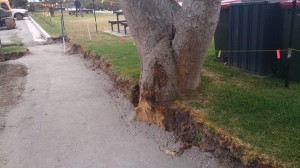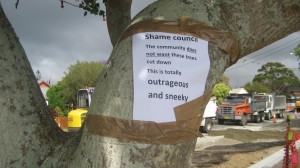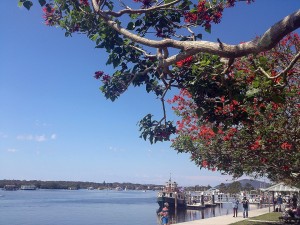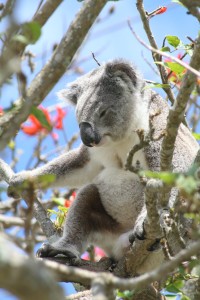Trees being cut at Tea Gardens Waterfront. Tea Gardens residents are concerned, confused and are trying to stop the, quietly scheduled, removal of the Marine Drive Coral trees by Great Lakes Council.
The removal of these Waterfront Tea Gardens Trees has been identified as part of the Marine Drive upgrade according to Great Lakes Council.
At 8am Wednesday morning 19th November, a large group of locals gathered on the waterfront to show their confusion, concern and disappointment.
Questions are being asked by local community groups, residents and business about why these six Coral trees need to be removed.
Trevor Jennings from the Progress Association said that there has not been adequate public consultation about the removal and is desperately trying to have the remove postpone until further discussion and consultation can be had with Council.
The Myall Coast News Facebook site has been active with concerned residents’ comments.
Myall Coast News contact Deputy Mayor Len Roberts.
Len Roberts told Myall Coast News, “Council established ten years ago that the trees were a noxious weed and would eventually need to be removed.”
“The trees have now reached their use by date and will likely impede on the road upgrade,” he said.
“Council’s intention was always to replace the existing trees with advanced natives to beautify the riverfront and to provide shade,” said Councillor Roberts.
Myall Coast News is in the process of talking to Council to ascertain if the remove is planned to go ahead and if so, what reasoning they have to remove the trees.
We will keep you updated.
Previous Related story: Len Roberts talking about the Coral Trees
Facebook comments about the issue
UPDATED: 11am 19 Nov
Gordon Grainger from the Myall River Progress Association lives on Marine drive and filed this report:
At the risk of some involvement—because I live along Marine Drive, I would like to add my two bob’s worth.
The general community seems divided between the trees to go or to stay.
The stayers are passionate, vocal and argue that the trees are attractive , provide shade in summer and light in winter, have been along the riverside for many years and are a landmark
ALL TRUE
The goers argue that the trees are unstable, considered a noxious weed by the Dept. of Agriculture, are not native to Australia and are a liability for falling limbs.
ALL TRUE
Then there is the general community. Most simply say “pity, they look nice, but” and many others who don’t give a rats.
All of which puts Council between a rock and a hard place. They have contracted to complete Marine Drive reconstruction and cannot please all the people, so hopefully I can add some food for thought.
The above link, clearly outlines the position taken by the NSW Dept. of Agriculture. It supports Council position.
The trees should be replaced.
We have known that position for at least 10 years, so the claims of being sneaky are only partly correct. I write partly, because Council should have advised the community of the pending removal, particularly as they had an information meeting in Tea Gardens last Monday. The timing is unfortunate, with summer and holiday season approaching.
It is my understanding that Council have now deferred the removal until that period is over, however the situation will need to be faced again in the New Year.
Council must provide information of what are to be replacement shade trees and those trees must be advanced enough to provide shade in a short period. An interim measure would be to provide additional shelters until the trees can take over.
A suggestion to be considered would be a staggered removal over a period of several years—taking 2 per year, replaced by the natives. That should provide a period of stability and satisfy most of the community.
UPDATED 3:30pm 19 Nov
Great Lakes Council says it is unfortunate but unavoidable that six coral trees along Marine Drive Tea Gardens (between Maxwell and Ogden Streets) need to be removed and replaced with a more appropriate tree species, as the first stage in improving the tree scape along the waterfront.
“Coral trees (Erythrina x sykesii) are identified as an environmental weed within the Great Lakes area and are recommended for removal where possible” said Council’s Manager of Parks and Recreation, Mr Andrew Staniland.
The coral tree has a substantial root system capable of damaging pipes and road pavements. Recent road works undertaken along this section of Marine Drive are in jeopardy of invasion by the root system of the coral trees.
“In addition, Coral Trees are prone to drop limbs and can present a hazard in public areas” said Mr Staniland.
“We are progressively removing them from our public reserves due to these issues and safety concerns. Most recently we removed six coral trees from the Lone Pine Memorial Park, Tuncurry and replaced them with suitable native shade trees, substantially improving the amenity and maintenance of the park” said Mr Staniland.
The six trees adjacent to the road works were scheduled for removal on 19 November but works have now been deferred until after the summer tourist season.
In the meantime action will be taken to plant replacement trees with the aim of having them established prior to the removal of the Coral Trees.
In addition to these identified six trees, Council will be systematically addressing all of the coral trees along Marine Drive and replacing them with appropriate native species.
UPDATED 20 Nov 9am
Coral Trees Tea Gardens by Deputy Mayor Len Roberts
There is some discussion in the community regarding the removal of coral trees in Marine Drive. These are the facts:
Erythrina is a genus (family) containing about 130 species of coral trees, and its name derives from the Greek word erythros, which means red. The leaves, bark and seeds are poisonous. The seeds are particularly toxic for children and can cause shortness of breath, cyanosis (when the skin gets a blue tint because there’s not enough oxygen in the blood), weakness and light-headedness.
Council cannot retain the trees. Irrespective of whether they are hybrid coral trees or other variety they are still coral trees and are listed as a noxious weed. Noxious does not necessarily mean poisonous but in a weed sense means harmful to the environment, whether to humans animals or plants. In New South Wales it has been reported to replace native riparian vegetation, block the flow of creeks, increase creek bank erosion, and cause other trees to fall over. Council has a legislated obligation to carry out requirements under the Noxious Weed Act which is: The plant must be fully and continuously suppressed and destroyed and the plant must not be sold, propagated or knowingly distributed. The only difference between the hybrid and other species is the hybrid seeds do not germinate. They are not fertile. However the seed still can cause harm and logs, branches and even twigs will grow into new plants and they break easily.
I am surprised that anyone who cares for the environment would be in favour of coral trees. Landcare groups across Australia work hard to eradicate them. In Lismore area they have become a real problem. They are an absolute pest to the environment. At certain times of the year they have a pungent smell. If you support the eradication of bitou, which is also listed as noxious, then logically you must support the eradication of coral trees. In this case even though the root system was professionally cut back council would still need to spend money on them to maintain them or to ensure their survival. This would be unlawful for council to do. The only option was to remove them. Could you imagine the environmental movement, OEH DPI endorsing spending money on a noxious plant? Of course not; we would be a laughing stock and rightly considered as abrogating our responsibility.
Cr McCaskie sought assurances that they would be replaced with mature trees and it was made a condition of approval. It was always the intention of council to plant mature trees.
After Leigh Allen and Trevor Cook contacted me yesterday morning and after Lee Anderson and others talked with the overseer onsite, Council agreed to postpone their removal until after the holiday season as concerns were raised about shade over the summer season. Council had other options in place to ensure adequate shade but the suggestion had merit and was a reasonable request. In order to ensure their viability council would need to stabilise the root system otherwise they would come down in a storm. By waiting till after the holiday season council will not be able to dig them out but will need to grind the stumps instead. This is an added cost to council. It is highly likely that as the roots have not been stabilised they may fall down in a storm. By delaying their removal this also gives us the opportunity to place the mature trees on site before removing the coral trees and allow people to visualise the planned improvements.
I must say I have had more people contact me in favour of their removal than against and many understood and expected that council would not do half a job. It is unfortunate that better information was not circulated. For that I humbly and without reservation apologise.
The trees need to go and will go. Their replacement will enhance the foreshore. Council robustly discussed the issue and it was a unanimous decision of council to remove them. Other councillors wanted to move and second the motion so that Carol and I would be saved from any potential backlash, but we said we were prepared to shoulder the responsibility.
It is important to note that council has very competent environmental staff and they base their recommendations on science and improvement of the environment. The decision was not made in a vacuum or as a shot at the residents. I repeat it was a unanimous decision of council and one that had to be made urgently. This council is not afraid to make the hard decisions. The urgent report is on the web. Many people who contacted us understood that council would not vandalise the environment but readily understood that we would have a good plan in place to ensure the enhancement. The works currently in progress are of a high standard and many compliment council on how well it is looking.
Carol and I live here we would not soil our own nest. We are fighting hard to improve the area and we believe we are making progress.
I am proud to have been part of this council who made a very wise decision for the environment and the eventual enhancement of the foreshore.
Letters to the Editor in edition 27 November 2015
Dear MCNOTA,
I don’t support the removal of all coral trees from the waterfront at once.
I understand that Great Lakes Council considers them a danger however, I note they have stood for over 50 years without incident.
If they are to be removed, I would prefer them to be replaced 1 or 2 at a time over a period of years.
This would allow replacement trees to grow to full height and provide valuable shade for the many residents and visitors that enjoy our natural surroundings.
I am disappointed Council did not consult further with the community before and after making such a considerable and contentious decision.
Mark and Karen McCormick, Myall Beans and Leaves
Dear MCNOTA,
In this age of climate change, skin cancers and the hottest November on record, Council decided, with no public notice, to cut down the majority of protective shade we have on our waterfront.
The impact of this decision and lack of vision is worrying.
We are currently experiencing an extraordinary early summer heat and we are told by the weather bureau there is a long and dangerously hot summer ahead.
The impact of the loss of these trees is threefold from Tea Gardens Hotel/Motels point of view:
Visually the waterfront will appear stark and bare and lose much of its character for visitors and locals.
Sitting in hot sun trying to have a picnic or enjoy any takeaway food will not only be unpleasant but will be a health hazard and not appealing.
Visitors and locals will be forced to find shaded areas for recreation elsewhere thus stripping the character and amenity of our waterfront and no doubt small businesses will pay the price during what should be a peak trading period.
The summer sustains business for the quieter spring, autumn and winter months of trade.
Loss of tourism also means less jobs for locals and has a flow on effect with diminishing visitation and stays.
Tourism is our major industry and flows through to all business in town including laundromats, tradesmen such as plumbers and electricians etc who service the holiday rental properties and accommodation, along with food suppliers and the list goes on.
Tea Gardens is one of the few NSW towns that actually faces it’s waterfront.
Areas such as Forster and Taree are just two examples of many towns that have their commercial buildings backs to the waterfront.
This is not the time to lay bare the waterfront.
We do not know what trees Council considers planting nor what size they will be when planted.
We must plan ahead carefully if we are not to lose the character of this unique and special community amenity.
There needs to be robust community discussion, not sudden action, to determine the way to move forward on this matter.
Lee Anderson, Tea Gardens Hotel/Motel
Dear MCNOTA,
When I was the Field Supervisor in Myall Lakes National Park, we had to remove Coral Trees as part of the Mungo Brush re-development.
Good reasons being 1. They weren’t native and therefore inappropriate in a National Park setting, and 2. They were huge and at the end of their lives were dropping big branches which were a public safety hazard.
The Coral trees along Marine drive had many many more years of shade provision and aesthetic benefit before they became a safety issue.
I’m happy to accept valid rationale for their removal, but it appears that the lack of public consultation on this issue will cause anger and frustration and is clearly not good policy, nor is it good for public confidence in “our” two Councillors who purport to represent us. Bad form all around.
Geoff Mason, Comment from Myall Coast News Facebook
Dear MCNOTA,
I love those trees, they are so beautiful.
They are a spectacular feature of the water front. What will replace them? How long before these new trees provide shade?
I took this photo a couple of months ago, when they were in flower. They are stunning trees.
Sheridon Rayment, Comment from Myall Coast News Facebook
Dear MCNOTA,
What is becoming of our little town when business owners and concerned residents threaten to chain themselves to the waterfront coral trees?
This is not the roaring Franklin river in wild western Tasmania; this is the murmuring Myall in sleepy Tea Gardens.
Six years ago after considerable community and authorities consultation, Council’s consultants recommended a section of Marine Drive be made one-way, retaining the grassed area but improving the angle parking.
Council duly put the report out for public comment.
We felt happy the community would get what it asked for; but to our amazement, not so. Council decided to specify a two way road.
When questioned Council said the decision was based on the number of letters received (from memory 6 against one way and 4 in favour).
How could a couple of residents overturn all that consultation – we were amazed, however Council offered a compromise – the trees would be protected by “kerb buildouts”
The Historical Society had sought reassurance the trees would be retained due to their historical significance to the town,
All seemed OK until 2 weeks ago when Council commenced the parking area WITHOUT any “kerb buildouts” severely damaging several trees.
Council’s solution, approved at a meeting 10 days ago, “remove them all …as soon as possible” moved and seconded by our 2 local Councillors – “prepared to shoulder the responsibility in the event of any community backlash”.
Surprisingly they “forgot” to mention this Council decision at the community information session just a week later.
Are we being taken for fools?
Trevor Cook, Tea Gardens
Dear MCNOTA,
As a qualified horticulturalist I would like to offer an opinion on the waterfront Coral Trees ( botanical name Erythrina x sykesii).
I believe some misinformation is circulating creating confusion on the matter and offer the following clarifications.
DISPERSAL.During my working life I have been involved in the removal of coral trees . If growing in the wrong location they are a weed capable of slowly spreading through bushland or by streams by vegetative means . That is branches can take root on contact with the ground. This is how they multiply. The waterfront coral trees though are a completely different kettle of fish . The chances of them spreading is like the chances of us winning the lottery . There is no surrounding bush , if a branch was to drop the council would pick it up , the trees do not overhang the river and even if they did there is nowhere in this salt water estuary where they would wash up and grow. Therefore in this situation I find it hard to justify their removal based on being a weed.
DANGER OF FALLING LIMBS. Related to above , if these trees are grown in rich alluvial soil in wet climates with a sheltered microclimate they can get top heavy and drop branches. Once again in this case I believe it is a different kettle of fish.These trees all their lives have been exposed to the strong salt laden summer northeasters and are growing in infertile soil. Since a young age and over the years in this windy infertile environment they have taken on a toughened shape and form that is different to other coral trees at risk of limb drop.Also there is no reason why the canopy cannot be thinned to reduce its weight.
ROOT DAMAGE Likewise I would imagine the roots are so toughened that only very major disturbance would have a significant effect on the canopy. I would be surprised if any limbs fall this summer as a result of the damage that has happened so far .( except ofcourse for the always indiscriminate lightning strike). But to be on the safe side , as above some of the canopy could be taken out to compensate for this imbalance. This is often done by arborists after inadverdant root disturbance.Even 50 per cent of the canopy of these trees could be selectively pruned without compromising shade or tree amenity .
ROOT INVASION. Engineers and arborists know how to prevent this from happening with various root guards and many other techniques.
TOXICITY. Nearly every shrub or tree on the planet has some sort of toxicity . Think about it – if all parts of plants were edible what we would have left ? Plants have evolved or been made by God to have toxic parts in order to protect them.The toxicity of the coral tree is pretty trivial , otherwise we would have fallen il long ago . Far more toxic plants are frangipennies , azaleas , hydrangeas ,most bulbs , tomato plants and wattles . Shall we destroy them?
MATURE TREES. There is much confusion as to what is a mature tree. It is unlikely that around $100,000 will be spent to completely dig up the waterfront and import trees half the size of the coral trees . By normal definition a mature tree is say 8 by 2ft leaf spread with 4 inch trunk. It will take 10 years at the very least to begin to produce effective shade. If the Coral trees were identified as having to go 10 years ago ,alternatives should have been planted then . Look towards the Coupland /Oyster Hut end of the waterfront . This is what it will look like should the coral trees be removed before replacements have had a chance to grow.
If I was in council’s position, considering the importance these trees currently serve, I would be planting “mature” replacements now, pruning some of the tree canopy, waiting about 10 years then removing coral trees as needed from then on.
Christian Patteson, Hawks Nest
Dear MCNOTA,
I live along Marine Drive and would like to offer my comments regarding the removal of the Coral Trees.
The general community seems divided between the trees to go or to stay.
The stayers are passionate, vocal and argue that the trees are attractive, provide shade in summer and light in winter, have been along the riverside for many years and are a landmark. ALL TRUE.
The goers argue that the trees are unstable, considered a noxious weed by the Dept. of Agriculture, are not native to Australia and are a liability for falling limbs. ALL TRUE.
Then there is the general community. Most simply say “pity, they look nice, but” and many others who don’t give a rats.
All of which puts Council between a rock and a hard place. They have contracted to complete Marine Drive reconstruction and cannot please all the people, so hopefully I can add some food for thought.
The NSW Dept. of Agriculture supports Councils position.
The trees should be replaced.
We have known that position for at least 10 years, so the claims of being sneaky are only partly correct.
I write partly, because Council should have advised the community of the pending removal, particularly as they had an information meeting in Tea Gardens last Monday.
The timing is unfortunate, with summer and holiday season approaching.
It is my understanding that Council have now deferred the removal until that period is over, however the situation will need to be faced again in the New Year.
Council must provide information of what are to be replacement shade trees and those trees must be advanced enough to provide shade in a short period.
An interim measure would be to provide additional shelters until the trees can take over.
A suggestion to be considered would be a staggered removal over a period of several years—taking 2 per year, replaced by the natives.
That should provide a period of stability and satisfy most of the community.
Gordon Grainger, Myall River Action Group
Dear MCNOTA,
I SNAPPED this fellow and named him ‘Coral’ for obvious reasons.
These trees are not only shelter for we humans.
C. Cook
Dear MCNOTA,
Regardless of what some may think, the coral trees along the Tea Gardens waterfront are iconic and, without them, the attractiveness of our town would not be complete.
To suggest removing them is a bold move and one which I believe the majority of residents would find abhorrent.
I attended a Council workshop about eight years ago where the traffic consultant recommended that Marine Drive be made one-way.
One of the reasons supporting his recommendation was the fact that a one-way carriageway is much narrower than two-way, even with angle parking on both sides, and this meant that the greenspace along the waterfront could be increased, not diminished as has happened with the current two-way arrangement.
Subsequently, as a member of the Progress Association, I spoke at length about the advantages of a one-way system and the possible deleterious effect that a widened two-way arrangement would have on the coral trees.
Even though the Progress Association advised Council of its concerns, that advice fell on deaf ears. Unfortunately, Council couldn’t see what was obvious to so many of us.
I was devastated a couple of weeks ago when I witnessed the trimming of the roots of a couple of the coral trees, necessary for the widening of the road.
This confirmed my view that Council really hadn’t planned this project correctly from the outset.
If the Council considers the trees to be noxious (and, I believe, this is in dispute), then why didn’t they remove them years ago when the road widening plans were approved so that alternative trees could have been planted and they could now be admired as mature shade trees.
If the community was consulted now about suitable trees for the waterfront, with the given parameters of shade in summer, light in winter, colourful flowers, hardiness and attractiveness, I think they would choose coral trees. Ironic, isn’t it!
Trevor Jennings, President/Secretary Hawks Nest / Tea Gardens Progress Association
Dear MCNOTA,
These iconic Coral trees must not be removed!
Although they are a declared weed, ours are a special case because they are NOT the poisonous variety, have essentially bonsaii’ed over their 60+ years on the waterfront (because of the salt-laden winds so don’t drop branches) and have not spread like a weed because of the road on one side and salty river on the other.
Ian Morphett, Myall Koala & Environment Group

